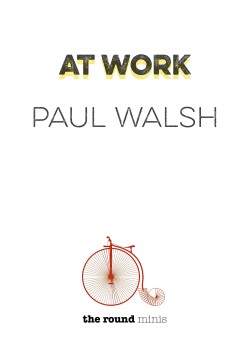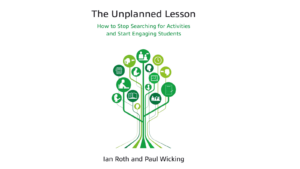Book Reviews: “Logic Activities” and “At Work”
“Logic Activities” by David Bougton
 “Logic Activities”, published in 2016, is written by David Boughton and is a very well-written eBook published by The Round. The previous eBook, “Brainstorming”, was reviewed here at EFL Magazine. The topic of logic and deductive reasoning is clearly illustrated and David highlights that a “logic activity is a series of clues that help you solve a puzzle” (Boughton 2016, p.5). The classic example of a logic activity is by the familiar puzzle of getting a cat, mouse and cheese across a river one at a time in one boat – for those of you who know the answer, feel free to leave it in a comment below.
“Logic Activities”, published in 2016, is written by David Boughton and is a very well-written eBook published by The Round. The previous eBook, “Brainstorming”, was reviewed here at EFL Magazine. The topic of logic and deductive reasoning is clearly illustrated and David highlights that a “logic activity is a series of clues that help you solve a puzzle” (Boughton 2016, p.5). The classic example of a logic activity is by the familiar puzzle of getting a cat, mouse and cheese across a river one at a time in one boat – for those of you who know the answer, feel free to leave it in a comment below.
Situation
Adam, Ben, and Cindy have different coloured bikes: red, blue, and yellow. Use the clues to decide the colour of each of their bikes.
Clues
- Ben’s bike is not blue or yellow.
- Cindy’s bike is not blue.
Excerpt From: David Boughton. “Logic Activities.” iBooks (p.5)
Also included in the introduction are some ideas on how to use logic activities in the classroom with learners. For example, David suggests getting students to do them either alone, with a partner or as a group as well as some extension activities which could be developed in the classroom.
After the comprehensive and clear introduction to the eBook, David offers additional lesson activities. There are a total of ten logic activities in this chapter which focus on a range of grammar or vocabulary points which could be used for supplementing something or the teacher deciding to do something completely different. My favourite lesson activity has to be the one called “Dan’s Family”. Each lesson activity is accompanied by the situation of the puzzle, the clues and the corresponding answers.
This eBook is recommended for teachers who are wishing to do something slightly different with their learners and those that wish to challenge their learners in slightly different manner. Teachers will find themselves inspired to create their own logic activities based upon the grammar or vocabulary focus of their lesson. Finally, with this eBook being priced at £0.99 on Amazon or $0.99 at Smashwords, it is at such an affordable price that you could just get it!
“At Work” by Paul Walsh
The second eBook review, for EFL Magazine, is again published by The Round and is “At Work” by Paul Walsh. It spans 59 pages and has six key chapters full of resources and an additional section about the author towards the end of the eBook. The eBook focuses solely on Business English and offers teaching ideas which could be incorporated into lessons.
review, for EFL Magazine, is again published by The Round and is “At Work” by Paul Walsh. It spans 59 pages and has six key chapters full of resources and an additional section about the author towards the end of the eBook. The eBook focuses solely on Business English and offers teaching ideas which could be incorporated into lessons.
The author, Paul Walsh, is an established teacher and teacher trainer with teaching experience in Berlin, Poland, Bulgaria and Saudi Arabia to name just a few countries. You can also find out a bit more about him from his website, Decentralised Teaching and Learning.
As with other similar eBooks, each chapter has a familiar format with each suggested lesson: the aim of the lesson, equipment required and the stages of the lesson. The eBook dives straight into the first section, called ‘Small Talk’, and is focused on fluency activities and getting students more comfortable at speaking in English. Within this chapter, there are 4 lesson ideas. My favourite activity from this is ‘The Watercooler’ idea as it promotes a conversation-led activity with less placed emphasis on materials – very much the main tenets of Dogme ELT. The other three tasks are well suited for a similar setup and provide some invaluable ideas for small talk.
The second chapter, named ‘Everyday life at work’, has three lesson ideas for readers which are related to activities at work, email, or office space. It is short but contains some valuable lesson ideas which the reader could plan into possible Business English lessons. The third chapter is all about ‘Statistics at work’ and includes three lesson ideas all based around this theme. The next chapter, ‘Time at Work’, is predictably associated with students and their workplace as well as the time that they spend there. The fifth chapter, containing another three lesson ideas, about ‘Problem-solving at work’, is clearly written and adaptable. The author has linked or referenced areas of inspiration for some of the lessons. The final chapter in the eBook contains four lessons which complement any communicative Business English classroom with an emphasis on ‘Roleplays at work’. There are some very engaging ideas in this section of the eBook and I look forward to incorporating these in a future Business English classroom.
The eBook is very well written and there is more focus on the tasks and lesson ideas at hand rather than padding this publication out with unnecessary principles. A reader would be able to incorporate the ideas presented immediately with very little preparation. I would recommend those teachers who have Business English classes purchase this eBook as it complements any coursebook with some genuinely great ideas to personalise lesson activities.




